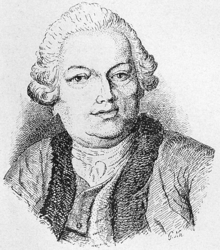Claude Bourgelat
 From Wikipedia the free encyclopedia
From Wikipedia the free encyclopedia
Claude Bourgelat | |
|---|---|
 | |
| Born | 27 March 1712 Lyon, France |
| Died | 3 January 1779 (aged 66) Paris |
| Known for | Scientifically informed veterinary medicine |
| Awards | French Academy of Sciences, Prussian Academy of Sciences |
| Scientific career | |
| Fields | Veterinary medicine |
| Institutions | Lyon Academy of Horsemanship, veterinary colleges at Lyon (founder) |

Claude Bourgelat (27 March 1712 – 3 January 1779) was a French veterinary surgeon. He was a founder of scientifically informed veterinary medicine, and he created the world's first two veterinary schools for professional training.
Life and career[edit]
Bourgelat was born at Lyon. He initially studied law and worked as a barrister, but he became interested in veterinary medicine because of his interest in horses.[1]
In 1740, at the age of 28, Bourgelat became the head of the Lyon Academy of Horsemanship.[1] As an amateur horsemanship enthusiast, he developed a style of horse riding that is still used as of today.[2] In 1750 Bourgelat wrote a book on the topic of veterinary medicine, in which he considered the idea of founding a veterinary school.[1]
He followed through on this idea when he co-founded the first two veterinary schools in the world, the École nationale vétérinaire de Lyon in 1761[a] and the École nationale vétérinaire d'Alfort in 1765.[1] He founded the veterinary college specifically to combat the cattle plague (also called the rinderpest), and students trained at the Lyon veterinary college were credited with helping to cure the disease.[3]

Bourgelat was noted for being an early practitioner of scientifically informed veterinary medicine, which incorporated ideas from natural history, chemistry, clinical medicine, and comparative anatomy.[4]
Bourgelat was a member of the French Academy of Sciences and the Prussian Academy of Sciences. He also contributed more than 235 articles to Diderot and d'Alambert's Encyclopédie, ou dictionnaire raisonné des sciences, des arts et des métiers.[5]
Selected works[edit]
- Élémens d'hippiatrique, ou, Nouveaux principes sur la connoissance et sur la médecine des chevaux (1750)
- L'art vétérinaire (1761)
- Matiere médicale raisonnée; ou, Précis des médicamens considérés dans leurs effets, a l'usage des éleves de l'Ecole royale vétérinaire; avec les formules médicinales. Lyon, Jean-Marie Bruyset (1765)
- Lehrbegriff der medicinischen Materie; oder, Beschreibung der einfachen Arzeneyen nach ihren Wirkungen; nebst den Medicinischen Formeln. Zum Gebrauche der Lehrlinge in der königl. Vieharzeneyschule zu Lyon. Aus dem Französischen übersetzt. Leipzig, M. G. Wiedmanns Erben und Reich (1766)
- Matiere médicale raisonnée, ou, Précis des médicamens considérés dans leurs effets. Lyon, Chez Jean-Marie Bruyset (1771)
- Elémens de l'art vétérinaire. Précis anatomique du corps du cheval, à l'usage des éleves des écoles vétérinaires. Paris, Vallat-la-Chapelle (1791)
See also[edit]
Notes[edit]
- ^ Also variously given as 1762 or 1764.
References[edit]
- ^ a b c d "Claude Bourgelat". Michigan State University. March 11, 2019. Retrieved 30 August 2020.
- ^ "Pioneering a profession: The birth of veterinary education in the Age of Enlightenment". American Veterinary Medical Association. December 19, 2010. Retrieved 30 August 2020.
- ^ J.L.Lupton, "Modern Practical Farriery", 1879, in the section: "The Diseases of Cattle Sheep and Pigs" pp. 1
- ^ Heintzman, Kit (2018). "A cabinet of the ordinary: domesticating veterinary education, 1766–1799" (PDF). The British Journal for the History of Science. 51 (2): 239–260. doi:10.1017/S0007087418000274. PMID 29665887. S2CID 4947361.
- ^ Frank A. Kafker: Notices sur les auteurs des dix-sept volumes de « discours » de l'Encyclopédie. Recherches sur Diderot et sur l'Encyclopédie. 1989, Volume 7, Numéro 7, p. 133
Further reading[edit]
- Marc Mammerickx: Claude Bourgelat: avocat des vétérinaires, Bruxelles 1971
- Hugues Plaideux, « L'inventaire après décès de Claude Bourgelat », in Bulletin de la Société française d'histoire de la médecine et des sciences vétérinaires, 10, 2010, p. 125-158.on line
- Hugues Plaideux, « La descendance de Claude Bourgelat », in Bulletin de la Société française d'histoire de la médecine et des sciences vétérinaires, 12, 2012, p. 161-176. on line
- Bourgelat, Claude, in: Frank Arthur Kafker, The encyclopedists as individuals: a biographical dictionary of the authors of the Encyclopédie, Oxford 1988, ISBN 0-7294-0368-8, p. 67–71.
- Richard Tagand: Claude Bourgelat, écuyer lyonnais, 1712–1779, in: Revue de médecine vétérinaire 1959, p. 888–897.
- Alcide Railliet, Léon Moulé: Histoire de l'École d'Alfort, Paris 1908, online
- Louis Furcy Grognier: Notice historique et raisonnée sur C. Bourgelat, Fondateur des écoles vétérinaires; ou l'on trouve un aperçu statistique sur ces établissemens, Paris [u.a.] 1805
This article incorporates text from a publication now in the public domain: Wood, James, ed. (1907). The Nuttall Encyclopædia. London and New York: Frederick Warne. {{cite encyclopedia}}: Missing or empty |title= (help)